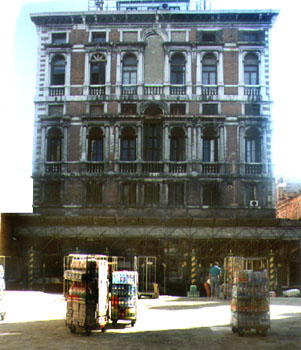Ca' Cornaro (later Mocenigo)Campo S. Polo (S. Polo 2128a)
In 1460 the brothers Cav. Marco Cornaro (B-16) and Proc. Andrea Cornaro (B-17) acquired the property from a later owner, Francesco Sforza, Duke of Milan, in a remarkable real estate transaction. The brothers sold to the Milan ruler the Ca' del Duca palace which they had recently begun constructing in the S. Samuele Parish on the Grand Canal. They received the S. Polo palace from Sforza in partial satisfaction of the purchase price for the Grand Canal property. The old S. Polo structure was one of three great palaces (the others were in S. Maurizio Parish and S. Cassiano Parish) owned by Cav. Marco's son Cav. Proc. Giorgio Cornaro (B-29) at his death in 1527. After the S. Maurizio palace was destroyed by fire, 1532, two of Giorgio's sons, Proc. Giacomo Cornaro (B-62/F-1) and Cav. Proc. Giovanni Cornaro (B-63/G-1), settled their families at the S. Polo palace. The S. Polo palace was then itself destroyed by fire, 1535. Cav. Proc. Giovanni received the site in the division with his brothers of the estate of their father. The present structure, designed by Michele Sanmicheli, was erected by Cav. Proc. Giovanni, 1555-64. In Jacopo Sansovino, Architecture and Patronage in Renaissance Italy (p. 140), Deborah Howard comments, "The palace at S. Polo . . . was intended to serve as two superimposed palaces, with the top storeys let out to another family as a source of extra income. This factor accounts for the remarkable height of the facade in proportion to its width. Sanmicheli coped with this difficult requirement by means of the ingenious use of large mezzanine windows in the facade, which enabled him to incorporate extra floors into the three-order elevation." The palace has a main staircase leading to the piano nobile and a small staircase to give separate access to the tenants on the top story. A major power center of Venice in the 16th century when three of Giovanni's progeny ascended to the Dogeship in quick seccession, the palace later passed to the Mocenigo family and to other owners thereafter. Early in the 20th century it was the site of a famous literary incident related by Hugh Honour in his guidebook to Venice (pp. 222-3): "Here Baron Corvo [the penname of an expatriate British writer] stayed while writing his last book, The Desire and Pursuit of the Whole. He showed the beautifully inscribed manuscript to his hostess who was so horrified by his descriptions of the members of the English colony in Venice that she promptly turned him out of doors. He was penniless, the weather was icy and he was forced to walk the streets for a night, with the result that he contracted pneumonia. But he recovered, and lived to add a singularly bitter account of his hosts to the book." Home | Palaces | Chapels | Villas | Paintings | Theaters Family | Links |